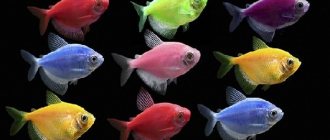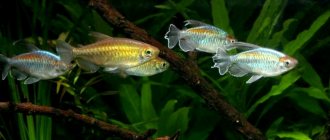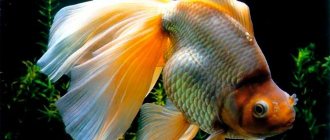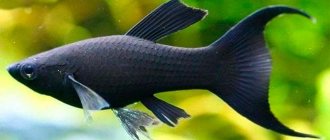Molliesia balloon is a breeding form obtained through long-term selection from mollies latipin. This fish has a very original shape, reminiscent of an inflated balloon. Thanks to this original body shape, it got its name. Due to the significant shortening of the body, the organs of this fish that ensure its life work with some tension, so it requires increased attention from the aquarist.
[sam_ad id=»15" codes=»true»]
Despite some difficulties in keeping this subspecies, thanks to its original shape and relatively small size, it can decorate almost any aquarium for both experienced aquarists and novice hobbyists.
Balloon mollies have a shortened body due to the shortening of the spine. In addition to the shortening of the spine, it is also somewhat curved. Due to this, the body length of the fish usually does not exceed 5 centimeters. Due to this modification of the body, the belly of the fish is greatly enlarged. This increase is due to the fact that the internal organs of the fish have not decreased. They need somewhere to be located. The main color of the fish is the same as that of its ancestor, the molly latipin. However, thanks to the efforts of breeders, a wide variety of color forms of balloon mollies . There are gray, black, spotted, orange, silver forms. Sex differences are the same as in all viviparous animals. Males have a pointed gonopodium in place of the anal fin. In females, the anal fin is rounded. The lifespan of this hybrid is 3-5 years.
External features
Mollies, photos of which are often featured in publications for aquarists, are viviparous fish. Natural habitat - salty and fresh waters of Latin America, from Colombia to Mexico. Males of mollies are much smaller than females; in nature, representatives of the species reach a length of ten to sixteen centimeters; in an aquarium they are much smaller - they do not exceed eight centimeters.
Mollies, photos of which you can see in this article, were discovered in the southern part of the United States and Central America. They began breeding it in aquariums in 1899, and the first hybrids appeared in the 20s of the 19th century. Under natural conditions, they are yellowish-gray or silver in color and have blue, bluish, green or black spots. The belly is usually lighter than the back and has no spots. The body is short, dense, the fins are strong and wide. However, through hybridization and cross-breeding, numerous color variations were obtained.
Mollies habitat
Mollies are native to Central America and the southern United States. Some species are found in the northern United States and Mexico, such as sphenops. In Guatemala, the peten and free-living live, and in the southeast of North America, in the fresh lakes and rivers of the Mexican Yucatan Peninsula, the sailfish or velifera live. Subsequently, mollies were distributed to Singapore, Israel, Japan and Taiwan. Some varieties are bred artificially and are not found in the wild.
Mollies in nature live in both fresh and brackish water of bays or on sea coasts. Occupies the brackish lower reaches of some rivers flowing into the Atlantic Ocean.
Mollies: description of the balloon variety
This variety also has a shortened body, with a noticeable curvature of the ridge. The balloon mollies fish does not grow more than six centimeters. Its peculiarity is its large abdomen. It is the result of modification of the species. Internal organs are compressed and small. The body color is somewhat reminiscent of the mollies latipin. But today individuals of other shades are widespread: orange, red, black, silver, gray.
These fish greatly decorate the aquarium, so for many hobbyists it is important that a balloon mollies live in their underwater kingdom. How to distinguish a female from a male? It’s quite simple - males have a cone-shaped genopodia (anal fin), while females have a rounded one.
Mollies content
It is necessary to provide the aquarium with a large number of open, well-lit areas. You will also need the presence of dense thickets of vegetation, snags, and rock slides for shelters. A significant part of the time, mollies swim in the middle and upper layers of the water of the aquarium.
All mollies are fairly heat-loving fish and prefer water with a temperature of 25 - 30 degrees. When the temperature of the water decreases or its quality properties deteriorate, and even more so when these unfavorable circumstances combine, they press all the fins to the body and move weakly, sometimes lying on the bottom or swaying in one place. This situation can often be corrected by increasing the temperature to the optimal value and replacing a third of the water with fresh, settled water. It is also a good idea to add sea or regular table salt to the water at a ratio of 2 - 3 g per 1 liter of water.
Fish are demanding when it comes to aquarium lighting - daylight should optimally last at least 12 hours. Lighting intensity at the rate of 0.5 - 0.7 W per liter with lamps with an increased red wavelength in the spectrum. It is a good idea to have the aquarium exposed to natural sunlight for 2 hours, but this is not necessary.
What to feed mollies?
Mollies are omnivorous and not picky. They are fed any live, dry or plant food. The diet of the fish must certainly include plant components. Make sure your fish's diet is as varied as possible.
Mollies balloon: keeping in an aquarium
These cute fish are not suitable for crowded small aquariums, although they are quite hardy and will survive even in such conditions, provided regular maintenance and care of their home. When the pH of water drops due to too much organic matter, fish can suffer. A molly aquarium should have regular water changes. A quarter of the total volume changes every 2-3 weeks. If the aquarium is overcrowded, this needs to be done more often.
There is one more feature of keeping mollies in a tank: you need to add two and a half teaspoons of aquarium salt to the water for every ten liters of water. Don’t forget to add salt water when changing. If you add water due to evaporation, then there is no need to add salt, since it remains in the aquarium.
Despite the fact that these fish prefer salt water, they feel great in fresh water, provided that it is not too acidic and soft. Water should be alkaline and hard.
Aquarium fish “Ballon”
The painstaking work of breeders made it possible to fix a genetic defect (deformity) that makes the fish more attractive and compact. Fish with a curved spine, a swollen round abdomen and highly compressed internal organs are usually called “Balloon” - Balloon, Potbelly.
We suggest you read: Reproduction and development of mollusks
When favorable conditions are created, Ballon fish can be successfully kept in aquariums and even reproduce. Subspecies “Ballon” were bred for several types of aquarium fish: Disc Pecilia (Pecilia balloon), Molliesia Ballon, Neon Ballon, Filomena Ballon.
Disc Poecilia
Xiphophorus maculatus – Platy Balloon
Mollies Ballon
Poecilia Balloon – Molly Balloon
Neon veil balloon
Paracheirodon innesi – Neon tetra Balloon Long Fin
Philomena Ballon
Moenkhausia sanctaefilomenae – Red Eye Tetra Balloon
The painstaking work of breeders made it possible to fix a genetic defect (deformity) that makes the fish more attractive and compact. Fish with a curved spine, a swollen round abdomen and highly compressed internal organs are usually called “Balloon” - Balloon, Potbelly.
When favorable conditions are created, Ballon fish can be successfully kept in aquariums and even reproduce. Subspecies “Ballon” were bred for several types of aquarium fish: Disc Pecilia (Pecilia balloon), Molliesia Ballon, Neon Ballon, Filomena Ballon.
Disc Poecilia
Xiphophorus maculatus – Platy Balloon
Mollies Ballon
Poecilia Balloon – Molly Balloon
Neon veil balloon
Paracheirodon innesi – Neon tetra Balloon Long Fin
Philomena Ballon
Moenkhausia sanctaefilomenae – Red Eye Tetra Balloon
Due to its unusual appearance, compact size and numerous color options, the Mollies Balloon has become a very popular aquarium fish. There are Balloon Mollies, both with regular fins, as well as High Fin and Lyretail Mollies.
- the recommended aquarium volume is at least 50 liters;
- lighting, thermostat, filter, compressor, soil and plants;
- water temperature 24-26 C, regularly replacing 1/5 of the volume of water with fresh water;
- Regular filter maintenance and fish feeding.
When choosing neighbors to keep Mollies Bolon, you should take into account that a large belly and impaired swimming functions make the fish less nimble and more active fish can prevent Mollies Ballon from getting enough food.
Any dry and frozen food of appropriate sizes. Due to the significant compaction of internal organs, dosed feeding without overeating is necessary.
This type of fish is unpretentious in care, but it is important to know the rules of keeping in order to ensure a long and happy life:
- Feeding is one-time, vary the diet, you cannot feed the fish only with animal food, they are omnivores, the food should be nutritious and varied, do not forget to use plant foods. You cannot overfeed fish; they will eat everything you offer, but this is harmful.
- Change the water once a week, mollies are sensitive to it, the water temperature for comfortable living of fish is 23–28 degrees, and the hardness is 25 dGH. And also provide the aquarium with a filter and a special compressor for aeration.
- It appreciates and loves free space, so maintaining one individual requires 20 liters of water or more. The fish grow large, so it is better to purchase a spacious aquarium.
- They love light, it is important to provide them with plenty of light; fish are exposed to light for at least 12 hours a day.
- To keep aquarium fish healthy, it is better to add salt to the water, according to the principle of 1 teaspoon per 20 liters of water.
- It is important to have snags, algae, other vegetation and shelters so that the fish feel comfortable.
Aquarium decoration
Balloon mollies need live plants in the aquarium. Fish love greens, especially when they add variety to their diet. But try not to overdo it with landscaping—mollies need room to move. Plants floating in the aquarium help the fry survive, and some of them provide additional food. You should not get carried away with picturesque snags - they reduce acidity, and this is undesirable for viviparous fish.
For the substrate, you can use any soil, although on lighter mollies the balloon will better demonstrate its beautiful color. Good filtration is necessary to maintain stable water levels. Additionally, males show their best colors in well-treated water.
These are quite active fish that need a lot of space to swim. If there are few fish, then the minimum volume of the aquarium should be at least 55 liters. If you keep a group of mollies, then it must be increased to at least 75 liters, and the ratio should be as follows: one male to three females. This will help you avoid quarrels between males. Preferred water temperature: 21-28 °C, pH: 7.0-8.5, hardness - 20-30 dGH.
Types of mollies
There are quite a few species of mollies grown in aquariums. Among them there are both natural and hybrid forms of this fish. The most common types of mollies are:
- M. velifera or sailus.
- M. sphenops (M. lyra, Black molly).
- M. freestyle.
- Marbled or white mollies (“snowflake”).
- “Golden” mollies or albino.
- M. latipin or broadfin.
- M. dwarf.
- M. Pétain.
- M. red or “red leopard”.
- M. yellow.
- M. silver spotted or M. Dalmatian.
- M. balloon.
- M. orange.
- M. highfin green.
- M. highfin orange.
- M. highfin silver.
Mollies Velifera or sailing molly
The homeland of this fish is hot Mexico. Velifera is considered the most beautiful species of mollies.
The body color of the velifera varies from green-blue to silver; the dots of a more saturated color form intricate patterns. The fins are transparent with pearlescent inclusions. The dorsal fin of adult males, irregularly trapezoidal in shape, reaches an impressive size.
Interesting: How to clean an aquarium at home
Along the upper edge of the male's dorsal fin, there is a chain of luminous red, yellow and blue dots. In males reared in good conditions, a pattern of symmetrical luminous lines .
Females are much paler and more modest in color than males. Fish of this species are quite large; even in an aquarium they grow up to 1 3–1 6 cm.
Unfortunately, this wonderful fish is now rarely found in aquariums. This is due to certain difficulties in breeding it. Velifers are very whimsical and capricious . They live in brackish warm water. Velifers love live food with the addition of algae. This type of fish grows rather slowly - males reach maturity only after a year.
If the conditions for keeping the velifera are not optimal, the fish grow pale and ugly, and the dorsal fin remains at the level of other species. And the fish loses its special beauty.
The necessary conditions:
- Temperature 24–26 degrees.
- Salinity up to 8%.
- Volume 70 liters per pair.
Mollies sphenops
This fish is also known as black Molly and Molly Lyra .
This is the most famous species of mollies. Sphenops has a dense, elongated body, a large head and large eyes. The fins are small, the tail is rounded. In an aquarium, males grow up to 6 cm, and females up to 10 cm in length. In captivity, these fish live up to 5 years. Natural sphenops are silver or yellowish in color with blue, black or green spots. The velvet black molly was artificially bred and became widely popular among aquarists.
There are several varieties of black mollies. In addition to classic fish with simple fins and medium sizes, there are Mollies with a high sail-shaped fin , as well as fish with an elongated dorsal and caudal fin.
Another of the hybrid forms of sphenops is yellow mollies . It is better to keep Sphenops in a school - these are very active and sociable fish. Sphenops love sunlight. There must be live plants and special shelters for fish. Gravel is best for soil.
The necessary conditions:
- temperature 24–27 degrees;
- dG H 11–25 g;
- pH 7.5–8;
- volume 10 liters per pair.
Marbled molly
It is also called “snowflake” or white mollies .
This hybrid form of sail molly was bred in the 90s. White mollies or “snowflake” received this name because of their amazing delicate color. Interesting: Features of caring for glass catfish
A dazzling white body with a bluish tint, black eyes and white fins with a blue tint make the fish fabulously beautiful. The size of adult fish is 10–12 cm. These fish love space, they are unpretentious, calm, and get along well with other species.
The necessary conditions:
- water temperature 23–27 degrees;
- dG H 8–25 g;
- salinity 5%;
- pH not less than 7;
- volume 60 liters per pair.
Mollies latipin or broadfin
This fish lives in southeastern and southwestern America. The latipina closely resembles the sailfin molly, but is distinguished by its rather modest size and small sail-shaped dorsal fin.
Its color is dull greenish-brown with red, blue or green dots. The fins are blue or transparent with black, orange or blue dots. Latipine is very rarely bred in aquariums.
Red mollies or “red leopard”
These fish have a bright red or red-orange color , sometimes with black spots, for which they received the second name - “red leopard”.
Peaceful, calm fish , they love aquariums with a lot of plants. Under good conditions, a leopard can grow up to 12 cm.
Leopards are vegetarians and prone to gluttony. To maintain and enhance the bright color, it is necessary to add food with a high content of carotene .
The necessary conditions:
- temperature 20–28 degrees;
- salinity 8%;
- pH 7–8.5;
- dG H 10–25 g;
- water volume 50–60 liters per couple.
Mollies orange
One of the most beautiful forms of sphenops. Loves bright sunlight and dense vegetation. Orange mollies, yellow mollies and red leopards require feed with a high content of carotene to maintain their bright colors. It can grow up to 12 cm, but more often its dimensions range from 5–7 cm.
The necessary conditions:
- temperature 23–28 degrees;
- salinity up to 8%;
- pH 7, 0–8.5;
- dG H 10–30 g;
- water volume 50–70 liters per couple.
Mollies balloon
A hybrid form of the broad-finned molly. very beautiful and unusual fish .
The main distinguishing feature of the balloon mollies is their swollen, round abdomen. There are veil and color forms. The size of a balloon mollies can vary from 2 cm to 13 cm. If the aquarium is small or the density of fish is high, the mollies will be small, but in a large spacious aquarium the fish will grow large. Fish can eat plants if there is little plant food in their diet. Ballon are big gluttons and often feed, so once a week they need to have a fasting day .
Ballon are very beautiful fish, but they do not live long. Their unusual shape is due to the curvature of the spine - scoliosis. This congenital disease cannot be cured.
Interesting: What to feed guppy fry from birth
The necessary conditions:
- temperature 20–25 degrees;
- salinity up to 8%;
- dG H 10–25 g;
- pH 7–8.5;
- water volume 50–70 liters per couple.
Feeding
Although experienced aquarists believe that the balloon molly is an omnivorous fish, we must not forget that it has a high need for plant food. The diet of this variety should include plenty of seaweed and other vegetarian foods. In nature, their diet consists mainly of rotifers and algae. Small aquatic insects and crustaceans make up an insignificant part.
In an aquarium, the balloon mollies happily eat ready-made food and live foods, but it especially values large amounts of plant food. Vegetable flakes combined with blanched spinach and fresh cucumbers will be an excellent addition to the main diet. Do not forget to promptly remove the remaining food. Between feedings, mollies will happily snack on aquarium plants and some aquarium algae.
These fish will not refuse protein food either, but they will not be able to exist solely on it. Treat them from time to time with brine shrimp (live or frozen), bloodworms, and tubifex. Meals should be varied, several times a day. Give food in small portions, in such quantity that it is eaten within three minutes.
Maintenance and care
The undemanding aquarium molly is popular among hobbyists who keep fish at home. A container of the most modest size can become a home for a small flock of mollies. A volume of 100 liters can be considered ideal for the life of mollies and getting maximum pleasure from watching them.
A heater is required. If the room temperature is expected to drop below 18-20 °C, a source of additional heat is simply necessary. At temperatures below 14 °C the fish dies. High temperature is also not desirable, it shortens the life of the fish. It is believed that ideally these fish like to swim in 25-degree water.
Mandatory equipment for any aquarium is a compressor for artificial aeration and saturation of water with oxygen. Maintaining the required hardness and acidity does not cause difficulties, since these parameters are in the middle of the possible range. Suitable acidity is around pH 7, hardness can be in the range dH 10-20.
Additional lighting of the aquarium is necessary for all its inhabitants. Aquatic plants are especially susceptible to it. Mollies feel good in the company of hornwort, egeria, pinnate and other common green aquarium inhabitants. The compatibility of mollies with greens is excellent.
Fish and plants feel quite comfortable next to each other. Molynesia is omnivorous, so it can eat a leaf or growth on a branch, but will not undermine the roots. Plants, not mollies, dictate what material is placed on the bottom. Usually this is coarse, washed sand or small stones.
Mollies do not rummage through the substrate in search of food. They can lift bloodworms or tubifex from the bottom, which, like other types of live food, are the best food for mollies. In addition, they are good at dry food. Molly fish are omnivores, do not show attachment to certain foods, actively peck growths on plant leaves, and sometimes pluck greens. They can feast on other people's caviar and their own offspring.
Mollies balloon: reproduction
Mollies are viviparous fish: the offspring are born fully adapted to life in water. The lifespan of this variety is from 3 to 5 years.
Mollies easily reproduce in an aquarium, and the offspring reach sexual maturity very quickly. Depending on the size of the fish and age, the female gives birth to up to one hundred fry. In addition, the peculiarity of viviparous fish is that the male’s sperm is stored in the female’s body for a long time. This allows fry to be born several times, even if the male is removed from the aquarium.
For breeding, you only need to purchase individuals of both sexes, and these fish will overpopulate the aquarium in a short time.
Difficulties in content
Most species of mollies are unpretentious and easy to care for aquarium fish. The only exception is balloon mollies, whose lifespan is very short due to congenital scoliosis and the problems associated with it. Keeping these fish is recommended only for experienced aquarists.
Caring for other mollies is not particularly difficult. The main possible difficulty is that these fish need space and a lot of living plants in the aquarium.
Keeping in an aquarium
Aquarium dimensions. To make a pair of mollies comfortable, you need 35-50 liters of water. The shape of the aquarium is not particularly important.
Water parameters. The water should have a constant temperature within 24–28°; sudden changes in any direction are unacceptable. Optimal hardness values are 22-28 dGH, PH - 7.1-7.9. Aquarium fish thrive in hard, brackish water.
Priming. Mollies live in the upper and middle layers of aquarium water, so any soil can be used. Sand, small pebbles, and decorative elements are suitable.
Plants. Aquarium mollies love live plants, from which they scrape plaque and eat leaves. Small-leaved algae and plants floating on the surface of the water are most suitable.
Scenery. Mollies love to hide, so it is advisable to decorate the aquarium with large driftwood, stone grottoes and slides, and thickets of living and artificial plants.
Lighting. All mollies living in the wild adore bright sunlight. Therefore, in the aquarium they also need to be provided with intense artificial lighting for 11–13 hours a day. There should be at least 0.5 V of light per liter of aquarium water.
Aeration. In water poor in oxygen, any mollies will not live long. Therefore, it is very important to equip the aquarium with a powerful compressor.
Filtration. These aquarium fish are very demanding when it comes to water purity! It is necessary not only to ensure excellent filtration, but also to replace at least a quarter of the water volume with fresh water weekly.
Behavior in the aquarium. Mollies are a peaceful and calm creature. She does not conflict with other inhabitants. In an aquarium it swims mainly in the middle layers of water, usually in a school with its relatives. If several males live in a small territory, they can fight and drive each other out.
Aquarium mollies love space, constantly swimming from one end of the aquarium to the other.
Feeding
Fish of this species can eat almost any food. But when compiling a diet, one should take into account the great need of mollies for plant foods. They can be easily distinguished from other inhabitants of the aquarium by their constant desire to scrape off any algae growth from the stones and walls of their home.
Main types of feed.
- NovoBel from JBL. A nutritional complex that is well balanced. It includes many components necessary for fish. Fully meets all the body needs of aquatic inhabitants.
- NovoColor from JBL . The fatty acids, carotenoids and natural components included in the composition improve the color of fish scales.
- Vipagran by sera . The main food for inhabitants of the middle layers of water. Available in the form of small granules, it contains a complex of plants, vitamins, proteins and many other valuable substances.
- MInBabyby TETRA . Nutritious balanced food for fry. It contains all the useful compounds and elements that kids need.
- MENU by TETRA . Long-lasting food in the form of flakes in 4 different colors. Red ones improve the fertility of females and males, chestnut ones strengthen the immune system, yellow ones promote full growth, and green ones increase the lifespan of fish. This food greatly simplifies the care and maintenance of platies.
Compatibility with other fish
Small, friendly mollies can coexist with any aquatic inhabitants. They cannot be housed only with predatory aggressive fish, which are capable of not only injuring, but also eating defenseless platies.
List of compatible fish.
- All small viviparous fish: guppies, platies, other types of mollies.
- Barbs.
- Gourami.
- Neons.
- Tetras.
- Sword bearers.
List of incompatible fish.
- Cichlids.
- Predatory catfish: sacbranch, clarius, red-tailed, orca.
- Tetradons.
- Sumatran and tiger barbs.
- Labeo.
Mollies diseases
Unfortunately, gentle mollies are susceptible to a number of different diseases. All of them are the result of incorrect content. You can distinguish a sick fish by its unusual behavior: lethargic or, conversely, restless.
Gas embolism.
Develops when there is an excess of oxygen in water. Most often this happens if you pour unsettled water straight from the tap into the aquarium. The disease is manifested by restlessness and darkening of the gills. Care and treatment in this case consists of replacing the water with a more suitable one.
Melanosis.
The body becomes covered with spots of non-standard colors, which subsequently turn into tumors. This problem cannot be cured. Prevention lies in creating the right conditions of detention.
Cold.
If the fish become lethargic and apathetic, swim near the surface, and lose their appetite, it means they have a cold. The disease occurs if the water in the aquarium is too cold for mollies. Care and treatment in this case consists of creating the optimal temperature of the habitat.
Lifespan
Depends on the type of mollies. The average lifespan is from 4 to 8 years. Females live slightly longer than males.
Balloon mollies can live no more than 2–3 years.
average price
The cost of the fish depends on the type. Regular mollies can be purchased for 45–60 rubles. Mollies of such species as snowflake, dalmatian, balloon are sold more expensively, their price is from 100 rubles.
Pregnancy
The pregnant balloon molly is clearly visible in the aquarium: it has a dark spot on the lower abdomen next to the anal fin and a large belly. Pregnancy in mollies lasts approximately four weeks, after which the fry are born. Many aquarists claim that with age, the largest individuals are capable of giving birth to up to two hundred and fifty fry.
In a community aquarium, the offspring can be eaten by adult fish if they are not removed in time. Floating plants can be used to protect them. After giving birth, the female does not immediately restore her “figure” - she still remains a little fat for some time. This is explained by the fact that she does not give birth to all the fry at one time, but continues to carry fertilized eggs. Thanks to this feature, the female molly is able to bear offspring for six months without any participation of the male.
Molly fry
We mentioned the endurance that balloon mollies have. Fry, unlike adults, are very sensitive to water parameters, especially with regard to harmful impurities. Frequent water renewal is recommended. To make it easier for the offspring to adapt and not be afraid to eat food (fry are afraid to take it in the first days of life), place Java moss in a container. The very first food for juveniles is ground food and small ciliates.
If you have nowhere to resettle the fry, use five-liter jars with settled running water. It is better to place the jars in a bright place, but they should not be exposed to direct sunlight.
Price
The current retail market for aquarium fish offers the widest selection of species and color forms of mollies or, as they are correctly called on labels and price tags, platies. Fish of simple and common colors are sold at prices starting from 50 rubles. White molly , or “snowflake”, is already more expensive, costing 100-150 rubles. And so on.
Guppies, which sellers never mix with other species and sell as an independent variety, start at 90-100 rubles. Private breeders-sellers ask for a lower price than stores. Who has a better quality product, whose fish will live longer is unknown.
The final price is affected by the color; in addition, larger fish are more expensive. The size of the fish indicates not only and not so much the age, but rather the conditions under which the fish are kept. Breeders of aquarium fish keep them in crowded conditions. Only with decent maintenance do fish have a chance to grow to their nominal size.
Compatibility
Mollies are active, but at the same time peaceful inhabitants of the aquarium; they are very sociable and love to live in the vicinity of their own species or with other viviparous fish. Males sometimes quarrel, but do not cause each other serious injuries. Only some fish exhibit a character that can manifest itself in aggressive behavior. Mollies can be kept with any fish that has a similar temperament and has the same requirements for the chemical composition of the water.
Avoid proximity to fish that can damage the fins of their peaceful neighbors. This primarily applies to the Sumatran barb. Bottom-dwelling catfish, corydoras, platies, other viviparous fish, and some species of rainbow fish will become their best neighbors. Tetras, cyprinids, and other characins, which are able to live in such water parameters, coexist well with mollies.
Mollies price and compatibility with other fish
Molly fish are small and friendly, so you can put them in the same aquarium with their own kind, from the platie genus. The neighborhood with barbs, swordtails, neons, and gouramis will also be calm. But you should avoid living together with slow veiled fish, since mollies are partial to their long, beautiful fins.
You cannot place mollies in the same body of water with predatory slaves of the cichlid family and catfish. Males of the same species may sometimes quarrel, but without much rage. To avoid this, you should not plant them in an aquarium that is too small. These are one of the most affordable fish; their price depends on the type. Some cost 45-60 rubles, and rarer, selective forms cost about 100 rubles.
Diseases
All inhabitants of the aquarium can get sick. The molly balloon is no exception. Most often, the cause of illnesses of this fish is hypothermia, inappropriate water parameters, and infections. The owner of an aquarium can very quickly notice signs of an incipient disease: pimples or dots appear on the scales, raised spots and ulcers can be seen on the skin.
Mollies that are black in color sometimes suffer from a condition called melanosis. This disease occurs due to increased pigmentation of the skin, which often causes tumors. To prevent many diseases, you should strictly monitor the temperature in the aquarium, the cleanliness of food, soil and decorations. Sick fish must be removed from the general aquarium. They should be quarantined in another tank and fed a balanced diet.











